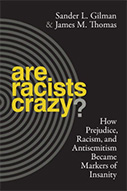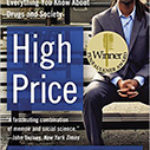Are Racists Crazy?: How Prejudice, Racism, And Antisemitism Became Markers Of Insanity

Authors: Sander L. Gilman and James M. Thomas
Publisher: New York University Press, 2016. 385p.
Reviewer: Mike W. Martin ǀ October 2017
This book deals with two questions, each important to law and public policy, as well as to ethics, education, therapy, and additional efforts to combat bigotry. The primary question—at least in terms of the bulk of pages devoted to it—is indicated in the subtitle: How did bigotry come to be regarded as psychopathology? The authors answer this question by providing a masterful intellectual history of how the social sciences discussed race and racism during the last century. The second question is suggested in the main title: Is bigotry an instance of psychopathology? According to the authors, it is not: “Racism . . . is real, but it is a political category, not a psychopathological one” (pp. 4-5). Their argument for this answer is murky.
Gilman and Thomas’s history of how bigotry came to be regarded as psychopathology defies simple summary. Here are a few themes, illustrated with regard to antisemitism. (The authors focus on antisemitism and white racism toward black people, although the book has implications for sexism, homophobia, and other prejudices.) From about 1890 to 1940, two striking reversals occurred in social-science scholarship. One reversal concerns how race is conceived: from a biological category to a socially-constructed category. At the beginning of the period, race was defined biologically. Specifically, Jews were believed to be a separate race, rather than simply a religious and ethnic group. In the eyes of antisemites, the Jewish race is inferior. By the end of the period, and continuing to the present, the biological definition of race was discredited.
Thereafter, some scholars abandoned the notion of multiple races altogether, dismissing it as a product of ignorance and racism, and replacing it with the concept of ethnicity. Other scholars retain a concept of race but redefine it as a socially-constructed category with significant implications for history, politics, and economics. Gilman and Thomas adopt the latter approach (p. 10).
A second reversal concerns pathologizing groups—that is, viewing particular groups (collectively and individually) in terms of psychopathology: from pathologizing oppressed groups to pathologizing oppressors (bigots). At the beginning of this period, and much earlier, Jews were denigrated as mentally inferior, morally degenerate, and diseased. By the end of the period the tables turned. Antisemites were diagnosed as sick. They were seen as paranoid, irrationally hateful, narcissistic, violent, and as having a “Jewphobia.”
Along the way the two reversals interacted and had sub-currents. For example, Jews who suffered from high incidences of psychopathology, such as depression and low self-esteem, were understood as “internalizing” the hatred aimed at them by antisemites, or perhaps as identifying with the oppressor’s society. This “internalizing” theme, prominent in Anna Freud’s writings, carried the risk of creating newer subtle forms of prejudice: for example, that Jews as a group are more susceptible to self-hatred than other groups. In addition, both reversals were influenced by dominant trends in the social sciences. For example, during the inter-war period, when the social sciences emphasized research on attitudes, there was a heavy emphasis on conceiving of bigotry in terms of irrational attitudes. Then, when people like Gustave Le Bon emphasized “the crowd,” the emphasis shifted to group influences in understanding both race and racism.
The reversal from oppressed-as-sick to oppressor-as-sick influenced the courts, for example in major decisions like Brown v. Board of Education. The writings of W. E. B. Du Bois, Gunnar Myrdal, Theodor W. Adorno, Kenneth and Mamie Clark and a cascade of additional thinkers nudged justices toward understanding segregation as fostering pathology in both oppressors and victims of oppression. These thinkers might understand racism primarily in cultural and political terms, but they found it “rhetorically effective” to use images of psychopathology in depicting racists as sick (p. 167).
Post-Holocaust and post-World War II, and continuing today, yet another (third!) shift occurred: “understandings of racism also shifted from a social and cultural effect to a pathological condition” (p. 223). Here Gilman and Thomas’s account becomes less clear. At times they seem to be claiming there is an absolute shift in perspective taking place, such that social-cultural understandings of bigotry are abandoned and replaced by psychopathological understandings. Other times they seem to claim instead that a shift in emphasis occurred (and is still taking place), such that psychopathological understandings are (sometimes?, usually?) more emphasized than social-cultural understandings.
For example, they discuss the psychiatrist Theodore Isaac Rubin as illustrating this shift. Rubin emphasizes pathological approaches to bigotry, but he explicitly acknowledges the role of additional factors: “Jew-hating or antisemitism is a nonorganic disease of the mind. . . . Though there are, as in all emotional illness, sociopolitical, economic factors, and effects, this [Jew-hating] is primarily a psychiatric problem” (p. 248). The authors obviously contest Rubin’s emphasis, but their presentation also makes clear that Rubin is not suggesting an abandonment of thinking of bigotry as a social-cultural phenomenon, as well as a matter of psychopathology.
Gilman and Thomas discuss in detail the attempt to get extreme bigotry recognized as a mental disorder by the American Psychiatric Association (APA), giving it a presence in the Diagnostic and Statistical Manual of Mental Disorders (DSM) (pp. 237-247). They point out that the APA continues to refuse to include bigotry, whether as a separate category (such as intolerance personality disorder) or as a subheading of paranoia or other obsessional disorders. Yet the mere attempt to include bigotry in the DSM in some way is cited by Gilman and Thomas as evidence that a sociological-political view of bigotry (as a social effect) is at risk of being replaced by a psychiatric-psychological view of bigotry (as a psychopathology). I doubt that is true. At the same time, I share the authors’ implied view that the DSM is not the final word on psychopathology. Directly or indirectly, the DSM entries are decided by votes of the APA members, and both the former inclusions in the DSM (prior to 1973 homosexuality was pathologized in DSM) and former exclusions have been influenced as much by politics as science.
This brings me to the second question, the one suggested in the main title. That provocative title is somewhat inflammatory, because the authors are not focusing narrowly on craziness in the sense of insanity. The real question they discuss is this: Is bigotry a psychopathology, in some way, at least in its extreme forms—its visceral, violent, seriously irrational forms? Gilman and Thomas apparently believe that their intellectual history—which is centered on debunking race as biological and delineating how bigotry became pathologized—provides an answer this second question. I don’t see how it does. Is there a genetic fallacy at work here, in moving from (a) an explanation of how bigotry came to be regarded by many scholars and by much of the public as a psychopathology to (b) the conclusion that bigotry is not a psychopathology? Certainly these two matters, indeed the two questions addressed by the authors in this book, need to be kept more clearly distinguished throughout.
In a fragmentary and cursory manner, Gilman and Thomas introduce additional arguments against regarding (even extreme) bigotry as a psychopathology. First, they suggest that doing so is at odds with the pervasiveness of racism in the general population: “Pathologies are, by definition, conditions of abnormality,” whereas racism permeates society and in that sense is normal and normative, or what Hannah Arendt called “banal” (p. 283; cf. p. 228, p. 242). But isn’t it possible for pathologies to be ubiquitous, commonplace, and even sometimes the statistical norm? If disorders of depression, anxiety, and addictions like over-eating and alcohol dependency occasionally reach the statistical threshold of 51% in a society, does that overthrow their status as disorders? (To answer this question, we might need a better definition of disorders than the DSM’s emphasis on mental dysfunction.)
Second, Gilman and Thomas worry that to pathologize racism invites excusing the wrongdoing of bigots—as mad, so not bad—thereby undermining legal and moral accountability. I agree this is a danger we should guard against. Yet, as Gilman and Thomas acknowledge, the courts (and psychiatrists) usually succeed in not allowing (most) mental disorders (short of insanity) as wholesale exculpation of guilt, even when they do allow it as one possible factor to be considered during the punishment stage of trials (p. 275). “For example, the 2017 Las Vegas mass murderer may well have been a sociopath, manifesting what the DSM calls Antisocial Personality Disorder, but neither the courts nor common opinion would regard his disorder as an excuse for his actions.” Even if extreme bigotry were included in the DSM, it would not provide an automatic excuse for bigots’ wrongdoing. In any case, Gilman and Thomas’s one-sided emphasis on social-political factors is equally subject to abuse—“Society made me a bigot, so I’m not blameworthy”—in ways that also need to be guarded against.
Third, the authors argue that pathologizing bigotry invites therapeutic responses to it and thereby “shifts attention away from policies directed at the social and structural level that have proven positive effects on reducing racial disparities” (p. 283). This is an important concern, but it is not a decisive consideration against pathologizing bigotry as one part of an integrated approach to understanding and combatting it.
Suppose we begin with a moral definition of (extreme) bigotry in terms of attitudes and conduct that fail to respect people, violate their rights, etc., on the basis of their race, ethnicity, sexual orientation, etc. Suppose further that (extreme) bigotry is explained partly in terms of psychopathology but also, perhaps primarily, in terms of social/political/legal/moral factors. Given these assumptions, combatting (extreme) bigotry might well require concerted action of multiple fronts (which is my view in From Morality to Mental Health, Oxford University Press, 2006). Any conflicts that arise concerning limited resources will need to be resolved contextually, looking at what works best in combatting it in particular situations, and at which new approaches and emphases warrant investigation—including approaches in sociology, political science, law, education, morality, and even experimental pharmaceutical approaches to bigotry that seem to alarm Gilman and Thomas (p. 1).
As an analogy, alcoholism (in the DSM, Alcohol-Related Disorders) has multiple causes, consequences, and even definitions in different disciplines. In combatting extreme cases involving serious harm to alcoholics and people they harm, we invoke law (drunk driving, drug courts, drinking age, etc.), psychology (various addiction therapies), medicine (detox facilities and pharmacological interventions), economics (sin taxes), etc. These multiple approaches need to be integrated, better than they are now. Likewise, we need an integration of many approaches in defining, explaining, and combatting extreme bigotry.
In fact, Gilman and Thomas invite multiple perspectives on bigotry with the one exception—therapeutic. They seem to embrace a dichotomy, or at least to gesture toward it: either psychopathology or a political category, either mad or bad, but not both. The dichotomizing emerges in their statement that racism is “a political category, not a psychopathological one” (p. 5). It enters in the opening pages where the potential use of pharmaceutical treatments for racist hate is glossed as the view that bigotry is “simply” a mental illness, as distinct from a social-political-moral matter that also has a therapeutic dimension (p. 4). In my view, we should reject the dichotomy as simplistic.
Finally, inspired by Foucault, Gilman and Thomas are preoccupied with possible abuses of psychology and medicine as “regimes of authority” with the power to label mental diseases and disorders (pp. 4, 16, 226). Along the way they identify many of these abuses, including how labeling both oppressors and oppressed people as sick leads to excesses and sometimes wild stereotypes (including the notion that all bigots are “crazy”). As a cautionary tale along these lines, Gilman and Thomas have written a very important book. Yet their view of bigotry as a political category should not cut off research into the ways in which much bigotry is also a matter of mental health. Their book should serve as a resource in moving toward a richer integration of political, legal, moral, and therapeutic viewpoints in understanding and combatting bigotry.
Reviewer Information: Mike W. Martin, Ph.D., Professor Emeritus of Philosophy, Chapman University


